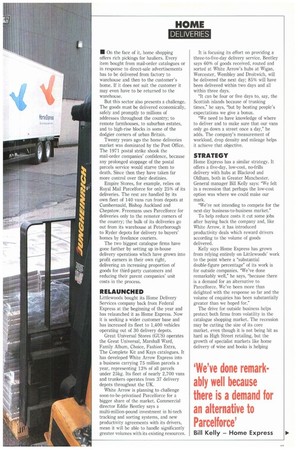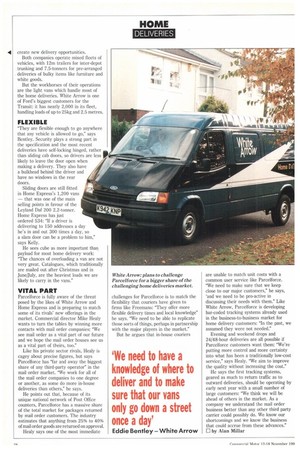HOME
Page 39

Page 40

If you've noticed an error in this article please click here to report it so we can fix it.
DELIVERIES
• On the face of it, home shopping offers rich pickings for hauliers. Every item bought from mail-order catalogues or in response to direct-sale advertisements has to be delivered from factory to warehouse and then to the customer's home. If it does not suit the customer it may even have to be returned to the warehouse.
But this sector also presents a challenge. The goods must be delivered economically, safely and promptly to millions of addresses throughout the country; to remote farmhouses, to suburban estates, and to high-rise blocks in some of the dodgier corners of urban Britain.
Twenty years ago the home deliveries market was dominated by the Post Office. The 1971 postal strike shook the mail-order companies' confidence, because any prolonged stoppage of the postal parcels service would starve them to death. Since then they have taken far more control over their destinies.
Empire Stores, for example, relies on Royal Mail Parcelforce for only 25% of its deliveries. The rest are handled by its own fleet of 140 vans run from depots at Cumbernauld, Bishop Auckland and Chepstow. Freemans uses Parcelforce for deliveries only to the remoter corners of the country; the bulk of its deliveries go out from its warehouse at Peterborough to Ryder depots for delivery to buyers' homes by freelance couriers.
The two biggest catalogue firms have gone further by setting up in-house delivery operations which have grown into profit earners in their own right, delivering an increasing proportion of goods for third-party customers and reducing their parent companies' unit costs in the process.
RELAUNCHED
Littlewoods bought its Home Delivery Services company back from Federal Express at the beginning of the year and has relaunched it as Home Express. Now it is seeking a wider customer base and has increased its fleet to 1,400 vehicles operating out of 30 delivery depots.
Great Universal Stores (GUS) operates the Great Universal, Marshall Ward, Family Album, Choice, Fashion Extra, The Complete Kit and Kays catalogues. It has developed White Arrow Express into a business carrying 75 million parcels a year, representing 13% of all parcels under 25kg. Its fleet of nearly 2,700 vans and trunkers operates from 37 delivery depots throughout the UK.
White Arrow is planning to challenge soon-to-be-privatised Parcelforce for a bigger share of the market. Commercial director Eddie Bentley says a multi-million-pound investment in hi-tech tracking and sorting systems, and new productivity agreements with its drivers, mean it will be able to handle significantly greater volumes with its existing resources. It is focusing its effort on providing a three-to-five-day delivery service. Bentley says 60% of goods received, routed and sorted at White Arrow's hubs at Wigan, Worcester, Wembley and Droitwich, will be delivered the next day; 85% will have been delivered within two days and all within three days.
"It can be four or five days to, say, the Scottish islands because of trunking times," he says, "but by beating people's expectations we give a bonus.
"We need to have knowledge of where to deliver and to make sure that our vans only go down a street once a day," he adds. The company's measurement of workload, drop density and mileage helps it achieve that objective.
STRATEGY
Home Express has a similar strategy. It offers a five-day, low-cost, no-frills delivery with hubs at Blackrod and Oldham, both in Greater Manchester. General manager Bill Kelly says: "We felt in a recession that perhaps the low-cost option was where we could make our mark.
"We're not intending to compete for the next-day business-to-business market."
To help reduce costs it cut some jobs after buying back the company and, like White Arrow, it has introduced productivity deals which reward drivers according to the volume of goods delivered.
Kelly says Home Express has grown from relying entirely on Littlewoods' work to the point where a "substantial double-figure percentage" of its work is for outside companies. "We've done remarkably well," he says, "because there is a demand for an alternative to Parcelforce. We've been more than delighted with the response so far and the volume of enquiries has been substantially greater than we hoped for."
The drive for outside business helps protect both firms from volatility in the catalogue shopping market. The recession may be cutting the size of its core market, even though it is not being hit as hard as High Street retailing, but the growth of specialist markets like home delivery of wine and books is helping create new delivery opportunities.
Both companies operate mixed fleets of vehicles, with 12m trailers for inter-depot trunking and 7,5-tonners for pre-arranged deliveries of bulky items like furniture and white goods.
But the workhorses of their operations are the light vans which handle most of the home deliveries. White Arrow is one of Ford's biggest customers for the Transit: it has nearly 2,000 in its fleet, handling loads of up to 25kg and 2.5 metres.
FLEXIBLE
"They are flexible enough to go anywhere that any vehicle is allowed to go," says Bentley. Security plays a strong part in the specification and the most recent deliveries have self-locking hinged, rather than sliding cab doors, so drivers are less likely to leave the door open when making a delivery. They also have a bulkhead behind the driver and have no windows in the rear doors.
Sliding doors are still fitted in Home Express's 1,200 vans — that was one of the main selling points in favour of the Leyland Daf 200 2.2-tonner. Home Express has just ordered 534: "If a driver is delivering to 150 addresses a day he's in and out 300 times a day, so a slam door can be a problem to him," says Kelly.
He sees cube as more important than payload for most home delivery work: "The chances of overloading a van are not very great. Catalogues, which traditionally are mailed out after Christmas and in June/July, are the heaviest loads we are likely to carry in the vans."
VITAL PART
Parcelforce is fully aware of the threat posed by the likes of White Arrow and Home Express and is preparing to match some of its rivals' new offerings in the market. Commercial director Mike Healy wants to turn the tables by winning more contacts with mail order companies: "We see mail order as a vital part of our future and we hope the mail order houses see us as a vital part of theirs, too."
Like his private sector rivals, Healy is cagey about precise figures, but says Parcelforce has "far and away the biggest share of any third-party operator" in the mail order market. "We work for all of the mail order companies to one degree or another, as some do more in-house deliveries than others," he says.
He points out that, because of its unique national network of Post Office counters, Parcelforce has a massive share of the total market for packages returned by mail order customers. The industry estimates that anything from 25% to 40% of mail order goods are returned on approval.
Healy says one of the most immediate challenges for Parcelforce is to match the flexibility that couriers have given to firms like Freemans: "They offer more flexible delivery times and local knowledge" he says. "We need to be able to replicate those sorts of things, perhaps in partnership with the major players in the market."
But he argues that in-house couriers are unable to match unit costs with a common user service like Parcelforce. "We need to make sure that we keep close to our major customers," he says, 'and we need to be pro-active in discussing their needs with them." Like White Arrow, Parcelforce is developing bar-coded tracking systems already used in the business-to-business market for home delivery customers: "In the past, we assumed they were not needed."
Evening and weekend drops and 24/48-hour deliveries are all possible if Parcelforce customers want them: "We're putting more control and more certainty into what has been a traditionally low-cost service," says Healy. 'We aim to improve the quality without increasing the cost."
He says the first tracking systems, geared as much to return traffic as to outward deliveries, should be operating by early next year with a small number of large customers: "We think we will be ahead of others in the market. As a company we understand the mail order business better than any other third party carrier could possibly do. We know our shortcomings and we know the business that could accrue from these advances." o by Alan Millar












































































